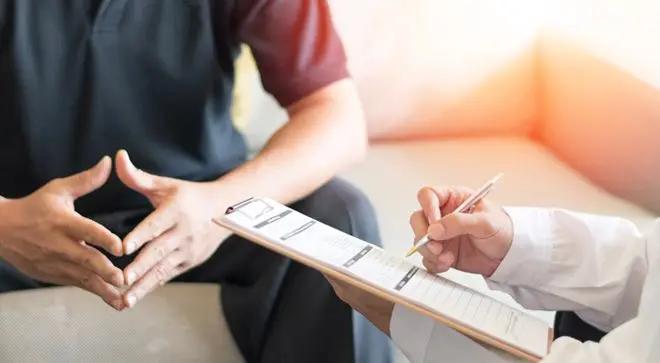Article
Informing the Patient of a Test Result
Cancer is a terrifying word. Here's how to let the patient know the news is bad.
'Cancer' is a terrifying word. The first time I heard the word directed at me was in 1996. I was 32 years old. I had just had a colposcopy after an irregular pap smear. The call from my gynecologist was forwarded to me at the library reference desk where I was working.
"The pathology report showed cancerous cells. We need to remove them. I'd like to do a LEEP procedure so we can get clean margins."
It was stage I cervical cancer. I was at work. I will never forget that feeling of shocked confusion as I finished my shift.
The phone would continue to be a part of my cancer journey.
In 2011, there was a suspicious mammogram, followed by a biopsy. I was informed by phone that the biopsy showed cancer. After the next test, an MRI, I was told by phone that the scan showed two distinct tumors in my breast. I was also told by phone that the HER2-positive breast cancer had spread to my bone and liver. This call was made by my oncologist's nurse practitioner as I was sitting down in the chair to receive my first chemo. The bone and CT scans had just been returned to my oncologist, and they were trying to stop the previously planned chemo so that we could change treatment direction in light of the new diagnosis. The nurse practitioner pronounced that the scans showed lesions on my bones and spots on my liver. In my mind, spots on the liver meant I was going to die and die soon. I had taken the call at the nurse's station. When I heard the nurse’s words, I began to sob and I began to hate the phone.
But as time went on, and I received more test results, I realized I didn’t hate the phone. I hated the way in which news was being delivered over the phone. The radiologist who called to confirm that the breast biopsy showed cancer was kind, measured and detailed in her report. I was grateful for this approach, even calmed. My gynecologist who called to tell me that the breast MRI showed two tumors had not even bothered to have the scan report in her hand during the call and was dismissive of my questions. The nurse practitioner who informed me of my stage 4 metastatic breast cancer turned out to be someone who lacked social skills and should not have been informing patients of any test results. It's all in how the informing is handled.
Certainly the topic of how patients prefer to be informed of test results is of great interest. The Breast Cancer Social Media (BCSM) Community, a group of doctors, researchers, patients and advocates is asking just this question in a survey How Do You Prefer to Receive Test Results (the survey is open until Oct 23). I have my own preferences in how I want to be informed of test results.
We all know that delivering bad news is horrible for the giver and the receiver. The key is to deliver the news with kindness, provide details of the findings and give a plan for going forward. Here are some do’s and don’ts (from my perspective) of informing a patient that they have cancer:
- As the test is being ordered, ask the patient how they prefer to hear the results — in person, phone or email. My suggestion is that, if this is a new condition to the patient or the patient is new to you, deliver the results in person. After that, phone or email is fine, as long as the patient prefers this.
- When delivering the news, make sure to have the results report in front of you and provide basic information about the findings, size of tumor(s), location, etc. Give the patient an idea of what cancer in these locations mean in terms of treatment, symptoms, etc.
- Do not give survival statistics to the patient. Ever. After my own diagnosis, an oncologist stated that how a patient does is dependent on the biology of the tumor and the biology of the person who has that tumor. I looked up the statistics after leaving the oncologist office, but I had gotten the message that every metastatic patient is unique before viewing those numbers. And the oncologist’s message gave me hope, which is a key element in living with cancer. Do not take away that hope.
- At same time, do not tell the patient that metastatic cancer is a chronic condition. It is not. Cancer will most likely kill that patient. A small, but increasing, percentage of metastatic cancer patients live for many years. Most don't. False hope only provides a higher place to fall from when the cancer does what it will, and that may end in a dangerous depression for the patient.
- Deliver the news with kindness. "The scans show that the cancer has spread. Here are the treatments available. There are several more treatments being developed. Patients have lived for years with this type of cancer. Every case is different."
- Stick to the reality of the situation at that point. Do not speculate about what may or may not happen: ascites, pleural effusion, death-bed scenes. Follow this rule at every point during the treatment. If the symptoms haven’t appeared yet, do not delve into them. Letting patients know about possible side effects for a treatment being discussed is helpful, but not when a patient is first being informed of test results. See the comment about hope. Looking down the road towards suffering and death is another way to take away a patient’s hope.
- With side effects of treatment in mind, ask the patient about their treatment goals and priorities. I've heard mothers of young children say that they are willing to deal with any side effect just so they can stay alive for their children. For me, my focus is on quality of life. Five months of weekly Taxol disabled me and took away all of my quality of life. I am determined to stay only on targeted therapies in order to preserve that quality of life. I also believe in the right to die and want this option available so that I am not forced to live my final days in a constant state of suffering. Each patient has different priorities and goals. Ask about them.
- Finally, ask the patient how they want to receive test results going forward. For me, receiving basic results via email is good. I prefer to receive more detailed results by phone — I just want to know the results. The key is in how the news is delivered. As I wrote, informing the patient with kindness, giving details about the findings and providing a plan going forward are the key.
Although everyone has their preference in how they want to receive test results, I thought it would be helpful to give some basic guidelines, based on my experience of receiving test results. To all the patients out there: Chime in about your preference via comments. Here’s a chance to let the incredible medical teams who are helping us know about how you’d like to be informed.




